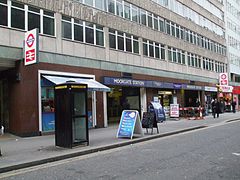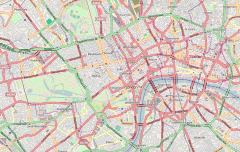- Moorgate station
-
Moorgate 

Entrance to Moorgate
Location of Moorgate in Central LondonLocation Moorgate Local authority City of London Managed by London Underground Station code MOG Number of platforms 8 Fare zone 1 London Underground annual entry and exit 2008  22.220 million[1]
22.220 million[1]2009  21.182 million[1]
21.182 million[1]2010  21.040 million[1]
21.040 million[1]National Rail annual entry and exit 2007-08  10.109 million[2]
10.109 million[2]- interchange  1.351 million[2]
1.351 million[2]2008-09  9.374 million[2]
9.374 million[2]- interchange  1.229 million[2]
1.229 million[2]2009-10  6.737 million[2]
6.737 million[2]- interchange  1.294 million[2]
1.294 million[2]1865 Opened (MR) 1900 Opened (C&SLR) 1904 Opened (GN&CR) List of stations Underground · National Rail External links Departures • Layout Facilities • Buses Coordinates: 51°31′07″N 0°05′19″W / 51.5186°N 0.0886°W
Moorgate station (formerly Moorgate Street) is a central London railway terminus and London Underground station on Moorgate in the City of London; it provides National Rail services by First Capital Connect for Hertford, Welwyn Garden City and Letchworth and also serves the Circle, Hammersmith & City, Metropolitan Lines and the Bank branch of the Northern Line. It was the terminus for the Moorgate branch of the Thameslink line until March 2009 and was the site of the Moorgate tube crash of 1975 when 46 people were killed and 74 were injured.[3]
Contents
Platforms
The Circle, Hammersmith & City and Metropolitan lines all use platforms 1 and 2 (through platforms) and also 3 and 4 (bays). The Northern line uses 7 and 8. National Rail services use platforms 9 and 10 (the Northern City Line platforms) and are signed as "trains to Stevenage". Platforms 5 and 6 are now unused since the Thameslink Programme cut off the Moorgate branch via the Widened Lines.
Traction current on the Underground lines is supplied by the standard London Underground four rail system. The former Thameslink bays were equipped with 25 kV AC overhead lines.
History
The station was opened by the Metropolitan Railway in December 1865 as the first extension from its original route between Paddington and Farringdon. The track to King's Cross was widened to four tracks in 1868 as the 'City Widened Lines'. These lines now form part of the Metropolitan line, Hammersmith & City and Circle lines and for a while formed the Moorgate branch of the Thameslink line.
The Northern line platforms were opened by the City & South London Railway (C&SLR) as "Moorgate Street" in February 1900 and formed the northern terminus of its services from Stockwell south of the River Thames. The line was extended to Angel the following year with services to London Midland Region (LMR) destinations using the Midland Main Line and Eastern Region (ER) destinations using the East Coast Main Line (ECML) (accessed via the York Road Curve and Hotel Curve to King's Cross). British Rail services to Moorgate were initially steam operated before being converted to Cravens-built diesel multiple units and British Rail Class 31 locomotives class hauling non-corridor stock which remained in operation until the mid 1970s.
The Northern City Line to Moorgate was opened by the Great Northern & City Railway (GN&CR) in February 1904 offering a service to Finsbury Park. The tunnels were constructed at a diameter capable of accommodating main line trains given the companies intentions to run main line trains via Finsbury Park directly into the city. Unfortunately the two companies were not able to agree and main line trains didn't use the lines for another 70 years.
The Snow Hill tunnel closed in 1916 after which Widened City Lines services terminated at Moorgate. From 1934 the Northern City Line was operated as the Highbury Branch of the Northern line.
Moorgate station was completely rebuilt and extended to six platforms in the 1960s.
46 people were killed and 74 seriously injured in the Moorgate tube crash on 28 February 1975 when a southbound train crashed into buffers at the end of the line at the station inside a tunnel beyond the platform. It was the greatest loss of life on the Underground during peacetime.
British Rail took over control of the Northern City Line from London Underground in 1975. The Highbury Branch of the Northern line was terminated. Services from Finsbury Park to Moorgate were diverted to the Northern City Line from the Widened City Lines the following year. The City Widened Lines had overhead electrification installed by 1982 allowing Midland City Line service to run from Bedford via the Midland Main Line to Moorgate on what became known as Moorgate branch of the Thameslink service. The Moorgate Thameslink branch closed permanently in March 2009 as part of the £6billion Thameslink programme.
The Trains do not serve the Northern City Line during late evenings and at weekends, being diverted to London Kings Cross instead.
Proposed developments
Crossrail
Under the Crossrail plans, the western ticket hall of Liverpool Street station will be situated just east of Moorgate station. An interchange will be built, which will also link Moorgate to the Central line .[4]
Services
London bus routes 21, 43, 76, 100, 133, 141, 153, 205, 214, 271 and night routes N21, N76, N133.
Preceding station  London Underground
London UndergroundFollowing station Barbicantowards HammersmithCircle line towards Edgware Road (via Aldgate)Hammersmith & City line towards BarkingBarbicanMetropolitan line towards AldgateNorthern line  National Rail
National RailOld Street First Capital Connect
Northern City Line
Monday-Friday onlyTerminus Disused railways Barbican First Capital Connect
ThameslinkTerminus Abandoned Northern Heights proposal Preceding station  London Underground
London UndergroundFollowing station towards Bushey HeathNorthern line towards Mordentowards Alexandra PalaceNorthern line Terminus References
- ^ a b c "Customer metrics: entries and exits". London Underground performance update. Transport for London. 2003-2010. http://www.tfl.gov.uk/tfl/corporate/modesoftransport/tube/performance/default.asp?onload=entryexit. Retrieved 8 May 2011.
- ^ a b c d e f "Station usage". Rail statistics. Office of Rail Regulation. 30 April 2010. http://www.rail-reg.gov.uk/server/show/nav.1529. Retrieved 17 January 2011. Please note: Some methodology may vary year on year.
- ^ History A Time Line for Policing the Railways
- ^ Tunnel Talk - see diagram
External links
- London Transport Museum Photographic Archive Moorgate station building in 1915.
Circle line Stations Aldgate · Baker Street · Barbican · Bayswater ·Blackfriars · Cannon Street
· Cannon Street  · Edgware Road · Embankment · Euston Square · Farringdon
· Edgware Road · Embankment · Euston Square · Farringdon  · Goldhawk Road · Gloucester Road · Great Portland Street · Hammersmith · High Street Kensington · King's Cross St. Pancras
· Goldhawk Road · Gloucester Road · Great Portland Street · Hammersmith · High Street Kensington · King's Cross St. Pancras  · Ladbroke Grove · Latimer Road · Liverpool Street
· Ladbroke Grove · Latimer Road · Liverpool Street  · Mansion House · Monument (
· Mansion House · Monument ( Bank) · Moorgate
Bank) · Moorgate  · Notting Hill Gate · Paddington
· Notting Hill Gate · Paddington  · Royal Oak · Shepherd's Bush Market · Sloane Square · South Kensington · St. James's Park · Temple · Tower Hill (
· Royal Oak · Shepherd's Bush Market · Sloane Square · South Kensington · St. James's Park · Temple · Tower Hill ( Tower Gateway) · Victoria
Tower Gateway) · Victoria  · Westbourne Park · Westminster · Wood Lane
· Westbourne Park · Westminster · Wood Lane

Click to enlargeRolling stock History Former companiesAssociated circle linesFuture proposals Future rolling stockSee also Hammersmith & City line Stations Aldgate East · Baker Street · Barbican · Barking · Bow Road · Bromley-by-Bow · East Ham · Edgware Road · Euston Square · Farringdon · Goldhawk Road · Great Portland Street · Hammersmith · King's Cross St. Pancras
· Goldhawk Road · Great Portland Street · Hammersmith · King's Cross St. Pancras  · Ladbroke Grove · Latimer Road · Liverpool Street
· Ladbroke Grove · Latimer Road · Liverpool Street  · Mile End · Moorgate
· Mile End · Moorgate  · Paddington
· Paddington  · Plaistow · Royal Oak · Shepherd's Bush Market · Stepney Green · Upton Park · West Ham
· Plaistow · Royal Oak · Shepherd's Bush Market · Stepney Green · Upton Park · West Ham  · Westbourne Park · Whitechapel · Wood Lane
· Westbourne Park · Whitechapel · Wood Lane

Click to enlargeRolling stock History Former companiesFuture proposals RouteFuture rolling stockSee also Metropolitan line Stations Central London sectionAldgate · Barbican · Euston Square · Farringdon · Great Portland Street · King's Cross St. Pancras
· Great Portland Street · King's Cross St. Pancras  · Liverpool Street
· Liverpool Street  · Moorgate
· Moorgate  Core sectionUxbridge branchOuter section & branchesAmersham
Core sectionUxbridge branchOuter section & branchesAmersham · Chalfont & Latimer
· Chalfont & Latimer  · Chesham · Chorleywood
· Chesham · Chorleywood  · Croxley · Moor Park · North Harrow · Northwood · Northwood Hills · Pinner · Rickmansworth
· Croxley · Moor Park · North Harrow · Northwood · Northwood Hills · Pinner · Rickmansworth  · Watford
· Watford

Click to enlargeRolling stock Present rolling stockHistory Former companiesClosed stationsBrill · Granborough Road · Lord's · Marlborough Road · Quainton Road · Swiss Cottage · Uxbridge Road · Verney Junction · Waddesdon · Waddesdon Road · Westcott · Winslow Road · Wood Siding · WottonFormer stationsAylesbury · Dollis Hill
· Dollis Hill  · Great Missenden
· Great Missenden  · Kensington (Olympia)
· Kensington (Olympia)  · Kilburn
· Kilburn  · Neasden
· Neasden  · Stoke Mandeville
· Stoke Mandeville  · Wendover
· Wendover  · West Hampstead
· West Hampstead  · Willesden Green
· Willesden Green  Transferred linesFormer rolling stockFormer locomotivesA Class · B Class · C Class · D Class · E Class · F Class · G Class · H Class · K Class · Met Electric Camelback · MetVick Electric BoBo · Metropolitan departmental · ex GWR · Metropolitan Railway Peckett Saddle Tank · Wotton TramwayMetro-Land
Transferred linesFormer rolling stockFormer locomotivesA Class · B Class · C Class · D Class · E Class · F Class · G Class · H Class · K Class · Met Electric Camelback · MetVick Electric BoBo · Metropolitan departmental · ex GWR · Metropolitan Railway Peckett Saddle Tank · Wotton TramwayMetro-LandFuture proposals Croxley Rail linkCroxley Rail Link · Ascot Road · Croxley · Croxley Green · Watford High Street · Watford Junction · Watford Stadium · Watford WestFuture rolling stockS Stock (Currently being rolled out)OtherWest Hampstead interchangeNorthern line Stations High Barnet branchEdgware branchBelsize Park · Brent Cross · Burnt Oak · Camden Town · Chalk Farm · Colindale · Edgware · Golders Green · Hampstead · Hendon CentralCharing Cross branchBank branchAngel · Bank · Borough · Camden Town · Elephant & Castle
· Borough · Camden Town · Elephant & Castle  (100m) · Euston
(100m) · Euston 
 · King's Cross St. Pancras
· King's Cross St. Pancras  · London Bridge
· London Bridge  · Moorgate
· Moorgate  · Old Street
· Old Street  Morden lineBalham · Clapham Common · Clapham North · Clapham South · Colliers Wood · Kennington · Morden · Oval · South Wimbledon · Stockwell · Tooting Bec · Tooting BroadwayFuture
Morden lineBalham · Clapham Common · Clapham North · Clapham South · Colliers Wood · Kennington · Morden · Oval · South Wimbledon · Stockwell · Tooting Bec · Tooting BroadwayFuture

Click to enlargeRolling stock Present stockHistory Former companiesFormer linesFormer stationsFormer rolling stock1906 Stock · 1938 Stock · 1949 Stock · 1956 Stock · 1959 Stock · 1962 Stock · 1972 Stock · Standard StockAbandoned plansFCC Great Northern Route GN Core Route Stations King's Cross • Finsbury Park • Harringay • Hornsey • Alexandra Palace • New Southgate • Oakleigh Park • New Barnet • Hadley Wood • Potters Bar • Brookmans Park • Welham Green • Hatfield • Welwyn Garden City • Welwyn North • Knebworth • Stevenage • HitchinNorthern City Line Hertford Loop Line Peterborough Line Hitchin-Cambridge Line Letchworth Garden city • Baldock • Ashwell & Morden • Royston • Meldreth • Shepreth • Foxton • CambridgeRoute TOC Previous TOC(s) West Anglia Great Northern (WAGN)Closed Line(s) Major railway stations in Britain Managed by Network Rail: Managed by train operator: Brighton • Bristol Parkway • Bristol Temple Meads • Cardiff Central • Cardiff Queen Street • Crewe • Doncaster • Glasgow Queen Street • Manchester Victoria • Newcastle • Nottingham • Reading • Sheffield • Southampton • YorkRailway stations of London: Central area | Greater LondonManaged by Network Rail: Managed by train operator: Blackfriars • Clapham Junction • City Thameslink • Marylebone • Moorgate • Stratford • Waterloo EastCategories:- Rail transport stations in London fare zone 1
- Northern Line stations
- Circle Line stations
- Hammersmith & City Line stations
- Metropolitan Line stations
- Tube stations in the City of London
- Railway stations in the City of London
- Railway termini in London
- Former Metropolitan Railway stations
- Railway stations opened in 1865
- Former City and South London Railway stations
- Railway stations opened in 1900
- Former Great Northern and City Railway stations
- Railway stations opened in 1904
- Railway stations closed in 1975
- Railway stations opened in 1976
- Railway stations served by Crossrail
- DfT Category E stations
- Barbican Estate
Wikimedia Foundation. 2010.



